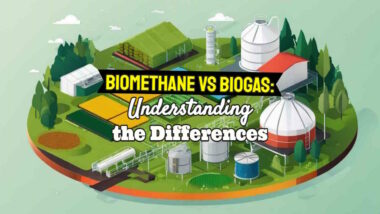In the quest for sustainable and renewable energy sources, biomethane emerges as a beacon of hope. At the heart of understanding and harnessing this resource lies a crucial process: the Biomethane Potential (BMP) Test. This test is more than just a procedure; it's a gateway to unlocking the energy potential hidden in organic waste materials. In this article, we delve into the intricacies of the BMP Test, exploring its significance, methodology, and the vital role it plays in the renewable energy landscape.
Appointing a Biomethane Potential Test Laboratory for any proposed biogas plant feedstock is an important early step in an anaerobic digestion plant project. In this article, we discuss the biomethane potential (BMP) test, which is a biological test to evaluate the potential methane/biogas volume generated from a feedstock.
Read on to find out more:
[boomdevs_toc]
Biomethane Potential Test Definition
Question: What is the Biomethane Potential (BMP) Test?
Answer: The Biomethane Potential Test is a laboratory procedure used to determine the amount of methane that can be produced from organic material through anaerobic digestion. It's a key analysis in the field of biogas production.
The biogas produced using the standard biogas test protocols is measured and converted to units of ml gas/gram VS (Volatile Solids) substrate at standard conditions for temperature and pressure (STP).
Analysis of Biomethane Potential (BMP)
Production of biogas from many different organic (mostly waste) materials is a feature of the biogas industry, and the availability of a wide range of feed materials is a major reason that many facilities can run their plants using this interesting source of renewable energy.
However, the biomethane potential (BMP) of these organic materials has to be determined to get an insight into the necessary design parameters for anaerobic digesters. This test is also essential to confirm assumed biogas yield estimates based on textbook data. The viability of many biogas projects often depends on these early tests.
When it comes to methane potential (biomethane potential) testing and anaerobic toxicity assays, the data from biomethane potential tests must meet the highest standards for accuracy and precision.
Some biogas plant operators do these tests themselves, and if they take great care to do them accurately, that can work well.
The BMP test is crucial to assessing whether the biogas yield will be enough for a plant to go ahead with new AD projects. For existing AD operators, these tests are used to base decisions on whether or not to accept novel incoming feedstock streams.
For that reason, we advise the users of these services to choose a leading supplier of analysis to the biogas industry with all relevant quality of service accreditations by the relevant third-party assessors.
Some Biomethane Potential Test Laboratories will also provide routine plant monitoring of substrate and digestate samples completed on the day of receipt of the sample.
Always check the turn-round periods with the lab before ordering a test. If a rapid service is needed. You may need to order an accelerated test report.
“The world today is in a constant quest to generate clean energy which would considerably reduce the emission of greenhouse gas (GHG) for better living conditions. Engaging a Biomethane Potential Test Laboratory is an important step in discovering whether any particular biomass source will provide a good biogas process feedstock.”
Towards a standardization of biomethane potential tests
Biomethane potential (BMP) tests, although routinely applied to measure the ultimate methane production from different organic materials, both liquid and solid, are far from trivial.
Several norms aimed at standardizing BMP tests, such as DIN 38414 tl8 (1985), ASTM d 5210 (1992), ASTM d 5511 (1994), ISO 11734 (1995), ISO 14853 (1998), and ISO 15985 (2004), have existed for many years, but their formulation of important parameters is often insufficiently specific.
Biomethane Potential Test Laboratory Procedures
Individual organisations have their own methods, so it is always important to discuss the detailed use of and interpretation of the protocols to be used on specific samples and to explain the intended use of the data to the lab in advance.
Compulsory elements for the validation of BMP test results
When considering appointing a new lab, we recommend discussing the application of industry-standard compulsory elements for the validation of BMP test results.
Multiple national and international inter-laboratory studies have shown rather low reproducibility in the measurement of biochemical methane potential (BMP), with differences for the same substrate exceeding a factor of two in some cases (Raposo et al).
Biomethane Potential (BMP) Test and the FOS/TAC Method Compared
Biomethane Potential (BMP) Test vs the FOS/TAC Method
The Biomethane Potential (BMP) Test and the FOS/TAC method are both related to anaerobic digestion, but they serve different purposes and are used in distinct stages of the biogas production process.
Biomethane Potential Test: The BMP Test is primarily a laboratory procedure used to estimate the maximum methane production potential of a given organic substrate. It's an analytical method conducted under controlled conditions to measure the amount of methane that can be generated from the substrate during anaerobic digestion. This test is usually performed before the actual anaerobic digestion process begins, often in the planning or development stages of a biogas project. It helps in assessing the feasibility of different substrates for biogas production and in designing the digestion process.
FOS/TAC Anaerobic Digestion Process Control: FOS/TAC, on the other hand, is a method used for monitoring and controlling the ongoing anaerobic digestion process. FOS (Volatile Fatty Acids) and TAC (Total Alkalinity) are parameters measured to assess the balance and health of the anaerobic digestion process. The FOS/TAC ratio gives insights into the process stability, indicating whether the digester is operating optimally or if it's at risk of acidification. This method is essential for the day-to-day management of a biogas plant, ensuring efficient and continuous production of biogas.
To sum up, the BMP Test is a predictive tool used to measure substrate quality and biogas potential, and the FOS/TAC method is a process control tool used to watch and improve an active anaerobic digestion process in real-time.
BMP Test Case Studies
1. Biomethane Potential Test Laboratory (BMP) Testing
Biomethane Potential Test Laboratory tests may be performed on several existing feedstocks to provide a means of cross-calibration with an AD plant owner's current feedstock results.
Comparative testing of Biomethane Potential may at times show a quite wide difference between the lab-derived biogas yield potential of a test in comparison with that achieved in a full-scale plant.
2. Defining the biomethane potential (BMP) of solid organic wastes and energy crops: a proposed protocol for batch assays
A proposed protocol for batch assays has been offered by researchers Angelidaki, i., Alves, M., Bolzonella, D., Borzacconi, l., Campos, j. L. Guwy, a. J., et al. (2009). In their paper, “Defining the biomethane potential (BMP) of solid organic wastes and energy crops: a proposed protocol for batch assays,”
3. “Biomethane Potential Tests – A Key Tool for Anaerobic Digestion Research and Practice”
A multi-channel analyzer was used to evaluate the biogas potential of sugarcane bagasse (SCB). The automatic methane potential test system contained fifteen parallel reactors and the same number of gas flow meters attached to the acquisition system.
The BMP test is commonly the first stage of assessment and comprises of a batch-test in-which a known quantity of feedstock is added to a seed digestate from a suitable AD process and the cumulative methane production is recorded over a 14 day test period.
1kg or 1L of feedstock is most often required for the testing.
Biomethane Potential Test FAQs
- Question: What is a Biomethane Potential (BMP) test?
Answer: A BMP test measures the potential of organic materials to produce biomethane under anaerobic digestion conditions. It's crucial for evaluating the feasibility of biogas production. - Question: How long does a BMP test typically take?
Answer: The duration varies based on the substrate and conditions but generally ranges from 30 to 60 days. - Question: What type of samples can be tested for BMP?
Answer: A variety of organic materials, including agricultural waste, food waste, and wastewater sludge, can be tested. - Question: Are there any specific preparation steps for the samples before testing?
Answer: Yes, samples usually need to be homogenized and sometimes pre-treated to ensure consistency and optimal biodegradability. - Question: What are the key parameters monitored during a BMP test?
Answer: Key parameters include biogas volume, methane concentration, pH, and temperature. - Question: Can BMP tests predict the actual biogas yield in full-scale plants?
Answer: While BMP tests provide valuable insights, actual yields can vary due to scale, feedstock variability, and operational conditions. - Question: How are the results of BMP tests presented?
Answer: Results are typically reported in terms of biogas or methane yield per unit of substrate (e.g., mL CH4/g VS). - Question: Is it necessary to replicate BMP tests?
Answer: Yes, replication is important for statistical reliability and to account for variability in biological processes. - Question: Can BMP tests be used for optimization of biogas plants?
Answer: Absolutely, BMP tests can guide feedstock selection and process optimization for enhanced biogas production. - Question: Do laboratories provide guidance on interpreting BMP test results?
Answer: Most labs offer detailed reports and can provide additional guidance on interpreting the results for specific applications.
[This article was first posted in January 2021. Updated December 2023.]







This was quite helpful and beneficial. after working out all of the specifics.